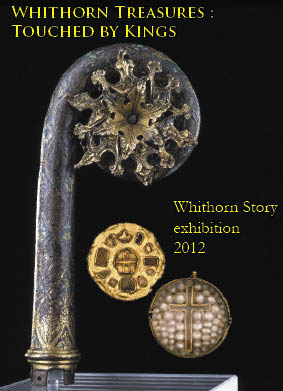The Whithorn reliquary pendant is on loan from the British Museum. This exquisite object is now in two pieces. The base is fashioned in gold with settings still holding some relics. The cover has pearls sewn with gold thread surrounding pieces of the true cross forming a crucifix. This is all topped with a piece of crystal which acts as a magnifying glass. Around the edge is an inscription listing the saints whose fragments of bone are carried in the settings.
The list begins with the True Cross and ends with the Virgin Mary, giving Christ and His Mother the place of honour. The second place on the list is held by St Ninian indicating that the reliquary was made for a church connected with the Saint. This is reinforced by the inclusion of Saint Norbet (D’NOR), the founder of the Order of Premonstratensian canons. Whithorn was the most important centre in Scotland of this Order. St Fergus was a Pictish Bishop of the 8th century and this could point to the rebuilding of Whithorn Cathedral by Fergus, Lord of Galloway, and would have wished to see a relic of the Saint, whose name he bore, included. The other saints listed are St George, St Margaret and St Boniface.
SE XPSTI – NINIANI – ANDRE EX MAURIS – GEORGII – MERG’ – D’NOR’ – FERG’ – BO NEF – SE MARIE
This will be the first time an object on loan from the British Museum has been shown in Whithorn. The new partnership between the Whithorn Trust and the British Museum will also see the prestigious annual Whithorn Lecture for 2012 being given by James Robinson, curator at the British Museum responsible for the non-ceramic medieval European collections.
John Orna Ornstein, Head of London and National Programmes said “We are really delighted to be able to lend the Whithorn reliquary pendant, and hope this will be the beginning of a productive partnership between The Whithorn Trust, National Museums Scotland and the British Museum”.
The Whithorn crozier is the most magnificent excavated treasure from the site. It was discovered in one of a series of graves in 1957 as work was undertaken on the crypts at the Priory. Despite its burial for over 600 years much of the decorative imagery is still visible with a series of figures, grotesques, a hare and a fish. The crozier, which dates from the 12th century, was used by the bishops of Whithorn until the 14th century when it was buried. The grave probably belonged to Simon of Wedale, who was bishop from 1326 to 1355. The crosier is crafted from copper alloy which is gilded and decorated with champlevé enamels.
The crosier is on loan to the Whithorn Trust from National Museums Scotland. In 2011 the Whithorn Trust and National Museums Scotland entered a new phase in their partnership which will see more key loans coming to the small museum deep in Dumfries and Galloway in the future.
Jilly Burns, National Partnerships Manager, National Museums Scotland says ‘We are delighted to be working in partnership with the Whithorn Trust and we look forward to exploring further loans to the venue over the coming years.’
Janet Butterworth of the Whithorn Trust says “we are extrememly grateful to both National Museums Scotland and the British Museum for their help and assistance and for making these objects available on loan. The crozier and reliquary pendant emphasise the importance and wealth of the Cathedral and Whithorn in the medieval period. The fame of Whithorn spread and inspired pilgrims, both commoners and kings, to visit the shrine of St Ninian. We can only imagine what it meant to people of that time to visit the shrine and to be close to such relics. The crozier, or bishop’s crook, was used by bishops for over two centuries and must have been used countless times. It was a powerful symbol of the head of such a rich and important church. It is entirely possible that Robert the Bruce held the reliquary pendant in his hand on his visit to seek a cure for his skin disease. Later kings, David II, James IV and James V all made pilgrimage to the shrine. The Premonstratensian Canons of Whithorn removed all of the relics at Whithorn to France at the time of the reformation but much disappeared in the French Revolution. Where the reliquary went then is anyone’s guess. It eventually turned up in 1946 when it was acquired by the British Museum from the executors of the estate of Maurice Eckstein. If these objects could speak to us, what stories could they tell of their time at Whithorn and the hands they passed through on their journeys”.


